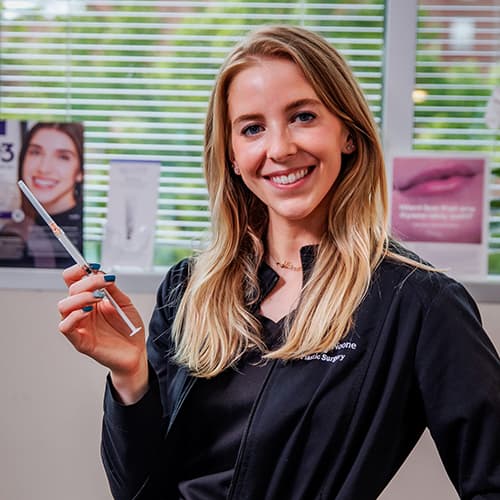RHA® Fillers (Hyaluronic Acid Filler)
Over time, our skin loses its youthful plumpness. That’s why we use dermal fillers to add customized volume just about anywhere you need it. But there is one caveat: filler is typically best used for static wrinkles or those that you can see even when your face is resting. Most fillers fade quickly when injected into dynamic wrinkles, such as the lines that form around the mouth when you smile, because the formulas break down more quickly in those areas.
The RHA® Collection of dermal fillers has changed the game. These are the first fillers that are FDA-approved to treat dynamic wrinkles and folds. These injectables are both flexible and strong, so you can enjoy smoother wrinkles while continuing to smile, laugh, and squint.
What are the new RHA fillers?
Hyaluronic acid is already widely used in fillers like Juvéderm® and Restylane® to replace lost volume in the skin. The Revance RHA collection of dermal fillers are 3 new formulas—RHA 2, 3, and 4—that use a special form of hyaluronic acid called “resilient hyaluronic acid.”
This resilient formula is designed to add lasting volume in expressive areas of the face that move frequently, helping you to look natural even while in motion. RHA can be used throughout the face and is even effective for replacing lost volume in the smile lines (nasolabial folds) that show when you laugh.
The molecules closely resemble those that naturally occur in our skin to help it retain moisture, and they therefore may be more resilient when injected beneath the skin. They are also often called “clean” and “natural” since they have undergone less processing and contain fewer additives.
What is RHA filler treatment like?
All RHA filler injections are performed in our office by either board certified plastic surgeon Dr. Brannon Claytor or physician assistant Julie Holesh. After working with you to determine where your RHA filler will be placed, we may apply a topical numbing cream and allow it to take effect before injecting you. While the injection is happening, you may feel some minor discomfort, but filler treatment is not usually painful.
Julie Holesh, PA
Physician assistant Julie Holesh is board-certified by the National Commission on Certification of Physician Assistants. With both an artistic eye and medical expertise, she can help you achieve optimal skin quality with injectables, laser treatments, and other med spa services.
What are common side effects of RHA filler?
Possible side effects after your RHA dermal filler injections are similar to those possible from other hyaluronic acid-based fillers and may include:
- Swelling
- Bruising
- Firmness or lumps
- Itching
- Tenderness
- Minor pain
- Redness or skin discoloration
While you may experience mild side effects in the treatment area, these typically subside in a matter of days. Avoid strenuous exercise, protect your skin from the sun, and wait to apply makeup for about 24 hours.
How long does RHA filler treatment last?
RHA filler may last up to 15 months. Results vary for each patient.
- Key Benefits
- Glossary
- Dynamic Adaptation: RHA fillers are designed to adapt to the movements of the face, providing a more natural look when smiling, frowning, or laughing.
- Long-Lasting Effects: These fillers offer prolonged aesthetic effects, maintaining their filling and smoothing properties for extended periods, often up to a year or more.
- Hydrated Appearance: Hyaluronic acid naturally attracts water, giving the skin a hydrated and plump appearance, which helps in smoothing out lines and wrinkles.
- Non-Invasive: As injectables, RHA fillers offer a non-surgical option for facial rejuvenation with minimal downtime and recovery needed.
Resilient Hyaluronic Acid: The proprietary hyaluronic acid used in RHA fillers.
Dermal Fillers: Substances injected into the skin to restore volume and smooth out wrinkles.
Nasolabial Folds: The deep lines running from the sides of the nose to the corners of the mouth.
Marionette Lines: Lines that run downward from the corners of the mouth.
Hydrophilic: Attraction to water; many dermal fillers have hydrophilic properties.
Hyaluronic Acid (HA): A naturally occurring substance in the skin that helps maintain volume and hydration.
Collagen: The main structural protein found in the skin and connective tissues.
Biodegradable Fillers: Fillers that are absorbed by the body over time.
Synthetic Fillers: Man-made substances used as dermal fillers, often providing longer-lasting results than natural fillers.
Cannula: A thin, flexible tube used to inject dermal fillers into the skin.
Volume Loss: Reduction of soft tissue in the face, often leading to wrinkles and lines.
Juvéderm®: A popular brand of hyaluronic acid dermal fillers.
Restylane®: Another brand of hyaluronic acid-based dermal fillers.
Restylane Lyft, or Perlane: A specific type of Restylane® used for deeper wrinkles and folds.
Voluma: An HA filler product designed to add volume to the cheeks.
Blepharoplasty: Surgical modification of the eyelid; sometimes related to dermal filler procedures for holistic facial rejuvenation.
Lip Augmentation: A procedure that uses dermal fillers to increase the fullness of the lips.
Radiesse®: A dermal filler brand known for stimulating the body’s collagen production.
Non-Surgical Rhinoplasty: Using dermal fillers to reshape the nose without surgery.
Liquid Facelift: A non-surgical procedure using injections of dermal fillers to restore facial volume and reduce wrinkles.
Glabellar Lines: The frown lines between the eyebrows.
Retouching: Follow-up treatments with dermal fillers to maintain or enhance previous results.
Injection Sites: Specific areas on the face where dermal fillers are applied.
Belotero®: A dermal filler that integrates with the skin tissue for natural-looking results.
Why choose RHA filler?
You may want to try RHA filler for a number of reasons:
- You want a cleaner product that mimics the structure of hyaluronic acid in your skin.
- You want to smooth your dynamic facial wrinkles, such as naso-labial folds.
- You were unhappy with the results of Botox and want a subtle “softening” effect to smooth your wrinkles and folds.
However, Botox, other fillers, and surgical lifts are still incredibly useful treatment options for treating wrinkles and signs of aging, so choose the procedure that is most likely to get the results you want. We work with each patient to decide which combination of procedures or treatments will best achieve your goals.
Can I combine RHA filler with other injectables?
Yes, it is safe to combine RHA filler with other injectables, such as neurotoxin or filler formulas from other lines, such as Bellafill®. Each filler is optimized for a certain area, so you and your injector may decide to mix and match filler formulas to get the results you want in various treatment areas.
Schedule your Philadelphia injectables consultation at Claytor Noone Plastic SurgeryPhiladelphia plastic surgeon Dr. Brannon Claytor and physician assistant Julie Holesh perform all injectable treatments here at Claytor Noone Plastic Surgery in Bryn Mawr, Pennsylvania. We provide a full range of premium products including Botox, Xeomin, DAXXIFY, and Dysport, as well as the dermal fillers Juvéderm, Restylane, the RHA filler collection, Bellafill and Sculptra Aesthetic so that we can always use the ideal procedure to meet your needs.
If you would like to learn more about RHA Fillers, contact our office today at 610.527.4833. Dr. Claytor serves Philadelphia, Bryn Mawr, Main Line including Villanova, Ardmore, Radnor and Lower Merion.
References »
Bukhari SNA, Roswandi NL, Waqas M, Habib H, Hussain F, Khan S, Sohail M, Ramli NA, Thu HE, Hussain Z. Hyaluronic acid, a promising skin rejuvenating biomedicine: A review of recent updates and pre-clinical and clinical investigations on cosmetic and nutricosmetic effects. International Journal of Biological Macromolecules. 2018 Dec;120(Pt B):1682-1695. doi: 10.1016/j.ijbiomac.2018.09.188.
Vidič M, Bartenjev I. An adverse reaction after hyaluronic acid filler application: a case report. Acta Dermatovenerol Alp Pannonica Adriat. 2018 Sep;27(3):165-167.
Nikolis A, Chesnut C, Biesman B, Alsufyani M, Boyd C, Lee W, Schwarcz R, Berros P, Andriopoulos B, Durairaj K. Expert Recommendations on the Use of Hyaluronic Acid Filler for Tear Trough Rejuvenation. Journal of Drugs in Dermatology. 2022 Apr 1;21(4):387-392. doi: 10.36849/JDD.6597.
Wu GT, Kam J, Bloom JD. Hyaluronic Acid Basics and Rheology. Facial Plastic Surgery Clinics of North America. 2022 Aug;30(3):301-308. doi: 10.1016/j.fsc.2022.03.004. PMID: 35934432.
Kim JE, Sykes JM. Hyaluronic acid fillers: history and overview. Facial Plastic Surgery & Aesthetic Medicine. 2011 Dec;27(6):523-8. doi: 10.1055/s-0031-1298785.
Areas Served:

Medically reviewed by Dr. R. Brannon Claytor — Updated on Feb 20, 2024


